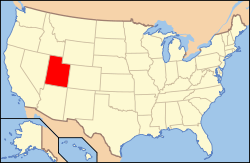Bonneville Speedway
Bonneville Speedway (also known as the Bonneville Salt Flats Race Track) is an area of the Bonneville Salt Flats northeast of Wendover, Utah, that is marked out for motor sports. It is particularly noted as the venue for numerous land speed records. The Bonneville Salt Flats Race Track is listed on the National Register of Historic Places.[1]
Bonneville Salt Flats Race Track | |
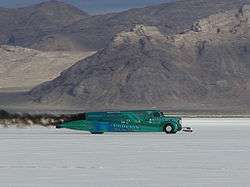 Phoenix Diesel Truck running at Bonneville, August 2003 | |
  | |
| Nearest city | Wendover, Utah |
|---|---|
| Coordinates | 40°45′45″N 113°53′44″W |
| Area | 36,650 acres (14,830 ha) |
| Built | 1911 |
| NRHP reference No. | 75001826[1] |
| Added to NRHP | March 16, 1984 |
The salt flats were first used for motor sports in 1912, but did not become truly popular until the 1930s when Ab Jenkins and Sir Malcolm Campbell competed to set land speed records.
A reduction of available racing surface and salt thickness has led to the cancellation of events at Bonneville, such as Speed Week in 2014 and 2015.[2] Available racing surface is much reduced with just 2.5 miles (4.0 km) available[2] instead of the 9-mile (14 km) courses traditionally used for Speed Week.[3]
Track layouts
Historically, the speedway was marked out by the Utah Department of Transportation at the start of each summer. Originally, two tracks were prepared; a 10-mile (16 km) long straightaway for speed trials and an oval or circular track for distance runs, which was typically between 10 and 12 miles (16 and 19 km) long depending on the condition of the salt surface.
Since at least the 1990s, track preparations have been the responsibility of the event organizers. Days or weeks in advance, the track preparers identify an area best suited for their track layouts and begin grading the tracks. Surveyors are brought in to survey the timing trap distances. A day before racing begins, the track markers are added.
Originally, the straightaway was marked with a broad black line down its center. This was eventually changed to lines down either side, as the center line wore out too quickly. As the costs for painting the lines has gone up, organizations have switched to flags and cones as track markers. The last event to use black lines was Speed Week, August 2009.[5]
The number of tracks and the timed sections for each track are set according to what is most beneficial for each event. Large public meets such as Speed Week run as many as four tracks with several timed miles, usually starting with the second mile and running to the fifth mile. Smaller meets that typically only run world record attempts will utilize a single track, with one timed mile and one timed kilometer in the middle of the track. Additional marks and cones indicate the end of the track and the position of timing equipment.
Deteriorating track conditions

The annual Speed Week was cancelled in both 2014 and 2015, as were many land-speed racing events, due to deteriorating track conditions.[2][3] Heavy rains caused a layer of mud from surrounding mountains to flow onto the flats, covering approximately 6 mi (9.7 km) of the track. Although another section of the flats would normally be used, nearby salt mining operations had reduced the size of the alternative track.[3]
The depth of the salt crust at Bonneville has also been decreasing, possibly leaching into a saltwater aquifer. Measured at as much at 3 ft (0.91 m) in the 1940s and 50s, it has been reduced to just 0.17 ft (0.052 m) in 2015.
Though recent studies have been made (since 1960), the causes of this deterioration are not clear, although the evidence points toward both local climatic changes and salt mining. Some strategies were devised to revert the decreasing salt surface, such as pumping back salt, though this had no effect.[3]
Events and meetings
In August, the Southern California Timing Association[6] and Bonneville Nationals Inc.[7] organize Speed Week, the largest meet of the year, which attracts several hundred drivers who compete to set highest speed in a range of categories.
In late August, the Bonneville Motorcycle Speed Trials are held.[8]
In September each year is the World of Speed, (similar to Speed Week) organized by the Utah Salt Flats Racing Association.[9] The USFRA also meet on the first Wednesday of each month throughout the summer.
In October, the Southern California Timing Association puts on World Finals, a scaled-down version of Speed Week.
Each year, there are usually a few private meets that are not publicized scattered among the larger public meets.
Land speed records
Numerous land speed records in various vehicle categories and classes have been set on the Bonneville speed way. In 1960, Mickey Thompson became the first American to break the 400 miles per hour (640 km/h) barrier, hitting 406.60 miles per hour (654.36 km/h) and surpassing John Cobb's 1947 one-way Land speed record of 403 miles per hour (649 km/h). Other notable examples of Bonneville speed records include:
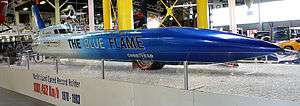
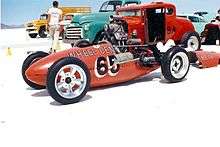
| Year | Driver | Vehicle | Speed mph | Speed km/h | Class (category) | Notes |
|---|---|---|---|---|---|---|
| 1935 | Sir Malcolm Campbell | Blue Bird | 301.129 | 484.620 | [data needed] | |
| 1947 | Don Waite | The Edelbrock Special | 192 | 309 | [data needed] | |
| 1954 | George J Smith | Harley-Davidson knucklehead | 152.02 | 244.652 | [data needed] | Modified 91 ci knucklehead / alcohol |
| 1963 | Craig Breedlove | Spirit of America | 407.447 | 655.722 | [data needed] | |
| 1963 | Dick Beith | Pepco 36 hp VW Lakester | 129.68 | 208.700 | K36 Unlimited | Pepco supercharged 36 hp based engine in a „Lakester” style car fashioned from a WWII aircraft belly tank |
| 1964 | Art Arfons | The Green Monster | 434.022 | 664.694 | [data needed] | |
| 1965 | Craig Breedlove | Spirit of America — Sonic 1 | 600.601 | 966.574 | [data needed] | |
| 1967 | Burt Munro | Indian Scout V-Twin | 184.037 | 296.179 | under 1,000 cc | |
| 1970 | Gary Gabelich | Blue Flame | 622.407 | 1001.67 | [data needed] | |
| 1971 | Warner Riley | Harley-Davidson Sportster | 206.544 | 332.400 | APS-AF 2000 | S&S Modified 96 ci Sportster/nitromethane |
| 1985 | Dan Kinsey | Tenacious Streamliner | 276.51 | 444.999 | S-F 2000 | S&S Modified 114 ci shovelhead/nitromethane |
| 1991 | Dan Kinsey | Tramp III Harley-Davidson | 226.148 | 363.949 | APS-AF 2000 | S&S Modified 114 ci Evolution big twin/nitromethane |
| 2001 | Don Vesco | Vesco Turbinator — Turbine Engine | 458.443 | 737.395 | [data needed] | |
| 2004 | R. Schroer | Buckeye Bullet — Electric Vehicle | 314.958 | 524.930 | [data needed] | |
| 2006 | Andy Green | JCB Dieselmax — Diesel Streamliner | 350.092 | 563.418 | FIA A-III-13 | World's Fastest Diesel |
| 2006 | Laura Klock | Harley-Davidson Road Glide | 143.659 | 231.197 | MPS-PF 3000 | "World's Fastest Bagger"[10] |
| 2007 | Erika Cobb | Buell Blast | 107 | 172.2 | MPS-PG 500 | [10] |
| 2007 | Laura Klock | Harley-Davidson Road Glide | 146.297 | 235.442 | MPS-PF 3000 | "World's Fastest Bagger"[10] |
| 2008 | Karlee Cobb | Buell Blast | 109.867 | 176.814 | MPS-PG 500 | Youngest person in the world at the time the record was set to hold a land speed record[10] |
| 2009 | Erika Cobb | Buell XB9 Firebolt | 126.383 | 203.394 | P-PP 1000 | [10] |
| 2009 | Karlee Cobb | Buell Blast | 115 | 185.075 | MPS-PG 500 | [10] |
| 2009 | Laura Klock | Victory Vision | 122 | 196.34 | MP-2000 | [10] |
| 2009 | Michelle Mielke | Yamaha Warrior | 143.154 | 230.384 | M-P-2000 | [10] |
| 2009 | Michelle Mielke | Yamaha Warrior | 143.725 | 231.303 | MPS-P 2000 | [10] |
| 2010 | Erika Cobb | Buell | 136.476 | 219.637 | P-PP 1000 | [10] |
| 2010 | Erika Cobb | Harley-Davidson Dyna with ProCharger | 143.542 | 231.008 | M-PBF 1650 | [10] |
| 2010 | Erika Cobb | Harley-Davidson Dyna with ProCharger | 141 | 226.918 | M-BF 1650 | [10] |
| 2010 | Karlee Cobb | Harley-Davidson Dyna with ProCharger | 151.754 | 244.224 | M-BG 1650 | [10] |
| 2010 | Chris Degen | Harley-Davidson | 127.571 | 205.306 | P-PP 1350 | [10] |
| 2010 | Charles Nearburg | Spirit of Rett | 414.316 | 666.776 | [data needed] | |
| 2011 | Erika Cobb | Harley-Davidson Dyna-Mite | 143.542 | 231.008 | M-P-BF 1650 | [10] |
| 2011 | Karlee Cobb | Harley-Davidson Dyna-Mite | 151.754 | 244.224 | M-BG 1650 | [10] |
| 2012 | Jeff Bailey | 1994 Harley-Davison Buell S2 | 226.148 | 322.797 | APS-AF 3000 | S&S 160 ci Prostock engine/gasoline |
| 2012 | Brian Klock | Harley-Davidson Dyna-Mite | 154 | 247.839 | MP-BG 1650 | [10] |
| 2012 | Brandon Nozaki Miller | 2012 Zero Motorcycles S ZF6 — Lightweight (under 150 kg) Unfaired Electric Motorcycle | 102.281 | 164.605 | First production electric motorcycle to break 100 mph | |
| 2016 | Roger Schroer | Venturi Buckeye Bullet 3 | 341.4 | 549.43 | FIA A-VIII-8 | Fastest electric vehicle |
| 2016 | Bob Sirna | Mercedes-Benz 300 SL | 190.759 | 306.997 | FIA A-VIII-8 | 3L Sport cars[11] |
| 2018 | Shigeru Yamashita | Kawasaki Ninja H2 | 209.442 | 337.06 | P-PB 1000 | Fastest street-legal production motorcycle[12] |
Cycling records
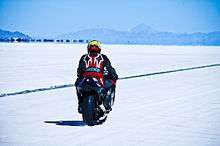
Several motor-paced racing speed records have been attempted at Bonneville.
In 1985, British cyclist John Howard set a then world record of 244 km/h (152 mph).
On 15 October 1995, Dutch cyclist Fred Rompelberg achieved 268.831 km/h (167.044 mph), using a special bicycle behind a dragster with a large shield.[13]
In 2016, Denise Mueller-Korenek claimed a women's bicycle land speed record at 147 mph (237 km/h). She was coached by Howard. It is not clear which authority was supervising the record attempt.[14]
In 2018, Mueller-Korenek broke her own women's record and the men's record at a speed of 183.9 miles per hour (296.0 km/h).[15]
In popular culture
In the series finale episode of Mad Men, Donald Draper drives a 1970 Chevrolet Chevelle SS muscle car in the races at Bonneville Speedway.[16] In the film The World's Fastest Indian Burt Munro and his highly modified Indian Scout motorcycle sets a world record.
See also
- Bonneville Motorcycle Speed Trials (BMST)
- Black Rock Desert
- Land speed record
- List of vehicle speed records
- The World's Fastest Indian - a biographical sports drama film involving the Bonneville Salt Flats.
- National Register of Historic Places listings in Tooele County, Utah
References
- "National Register Information System". National Register of Historic Places. National Park Service. July 9, 2010.
- Traugott, Jay (22 Jul 2015). "They Just Cancelled Speed Week At Bonneville For The Second Year In A Row". carbuzz.com. Retrieved 6 Dec 2018.
- Penrod, Emma (12 Jul 2015). "Utah's Famous Bonneville Salt Flats are Disappearing". The Salt Lake Tribune. Huntsman Family Investments, LLC. Archived from the original on 14 July 2015.
- Lohnes, Brian (9 Aug 2007). "The Salt Beds Of Salduro Chapter 5: Ernie Moross, Bill Rishel, Teddy Tetzlaff and the Blitzen Benz II arrive on the Salt Beds of Salduro". bangshift.com. Retrieved 6 Dec 2018.
- "Southern California Timing Association, What's New". scta-bni.org. Archived from the original on 13 April 2010. Retrieved 6 Dec 2018 – via Wayback Machine.
- "Southern California Timing Association". scta-bni.org. Retrieved 6 Dec 2018.
- "Bonneville Nationals Inc". scta-bni.org. Archived from the original on 23 February 2008. Retrieved 6 Dec 2018 – via Wayback Machine.
- "BMST".
- "Utah Salt Flats Racing Association". saltflats.com. Retrieved 6 Dec 2018.
- Carpenter, Michelle. "Klocked: Women with Horsepower". Klocked: Women with Horsepower. Retrieved 25 April 2018.
- McGraw, Jim (November 2016). "Bonneville Bob, Big Pete, Tall Mike and the Gullwing". Vintage Motorsport.:64-69
- Clark, Ben (23 Aug 2018). "Kawasaki Ninja H2 hits 209mph at Bonneville Speed Week". Motor Cycle News. Retrieved 6 Dec 2018.
- "The formidable record of Fred Rompelberg and its development". fredrompelberg.com. Archived from the original on 6 October 2010. Retrieved 8 Oct 2010 – via Wayback Machine.
- Legan, Kristen. "American woman rides bike 147 mph, a new world record". velonews.competitor.com. Retrieved 14 Sep 2016.
- "Woman Rides Bicycle To 183.9 MPH — A World Record". npr.org. National Public Radio. Retrieved 19 Sep 2018.
- Preston, Benjamin (19 May 2015). "Don Draper, Mad Men, the Chevrolet Chevelle, and the End of Innocence". Auto World News.
- Utah Salt FlatsRacing Association
- Southern California Timing Association/Bonneville Nationals, Inc.
- "One Out Of Three Smashes Up." Popular Mechanics, August 1954, pp. 65–70/240, see page 70.
External links
| Wikimedia Commons has media related to Bonneville Speedway. |

